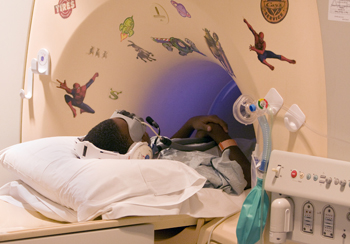
Rahsaan Howard, 10, wears special goggles that allow him to watch television while getting an MRI on his knee at the Monroe Carell Jr. Children’s Hospital at Vanderbilt. The goggles are part of a new program to help children stay still during lengthy diagnostic procedures. (photo by Joe Howell)
New system helps young patients hold still for MRIs
When Randy Howard brought his 10-year-old son, Rahsaan, to the Monroe Carell Jr. Children's Hospital at Vanderbilt for an MRI of his knee, he came prepared with earplugs and something to read.
Howard knew it would be a very loud, long and excruciatingly boring 30 minutes for both of them.
“My younger son had an MRI a couple of years ago and had to be sedated,” Howard recalled. “But he didn't understand. Rahsaan is older and kind of like me: he's calm and low-key. I knew he'd probably do fine.”
But as luck would have it, the Antioch fifth grader was offered a whole new form of “sedation” — television. Rahsaan was fitted with a set of goggles, headphones and a selection of TV shows or movies to watch for the duration of the MRI.
The Cinema Vision High Definition system is a gift from the Junior League of Nashville to the Pediatric Diagnostic Imaging Program. The distraction and entertainment offered by the goggles and headset saves scanner staff from having to beg children to hold still for long periods, and, more importantly, it may reduce the need to use sedating drugs.
“We will be tracking the device's use, but it will be difficult to quantify how many cases really avoid sedation. We hope it might be as much as one case a week,” said Kim Halliburton, director of Pediatric Diagnostic Imaging. “But if it reduces anxiety in a child and improves their experience here, it's worth it.”
About 80 percent of the pediatric MRI scans at Vanderbilt are brain studies. The average time it takes to complete a brain MRI under sedation is one hour.
If you consider the MRI suite, which houses two scanners and handles the scans of 17 children a day on average, you can see there isn't a whole lot of wiggle room in the schedule.
Currently, to reduce the use of sedation, a child can be put through a 15-minute “evaluation scout” to see if they can hold still enough.
If the child fails the scout, the sedation team is called, IVs are started and the schedule will be impacted.
Halliburton says it will be interesting to see if more scouts are successful with the goggles.
“The very first patient to use it was about 7 and his mom told us he would never make it through sitting still,” recalled radiologic technologist Rhonda Rippy.
“But we popped in ‘Sponge Bob’ and he did not move a muscle. He was perfect.”
The headgear, goggles and cords have no metal parts because metal would be pulled with great force into the imaging system's magnet. Staff outside the thick walls can communicate with the patient through the headphones and a microphone on the patient's headset.
Rahsaan Howard could have asked to turn up the volume on his headset because the loud clicks of the scanner drowned out the dialogue of “The Incredibles.”
He didn't because he said he didn't want to bother the staff, but still said he loved having the movie to watch.
“He did great,” said Joy McKinney, radiologic technologist.
“There was only one section I had to re-scan because he moved a little, but that only added about five minutes to the scan.”













